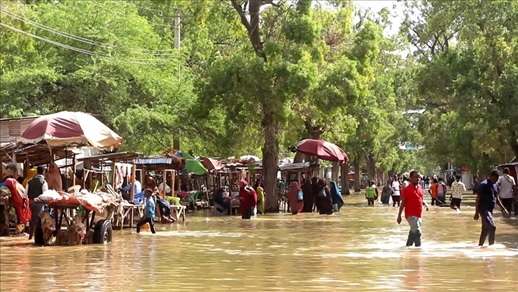BAIDOA, Somalia– It was in the afternoon on Oct. 4 that heavy rains started in the city of Baidoa, which houses over 600,000 internally displaced people dependent on UN and other international humanitarian assistance.

The downpour affected shelters hosting a total of 86,700 displaced people across 136 sites throughout the city, which is the administrative capital of South West State.
The families affected by the heavy rains and floods had originally fled from their homes in other parts of the Horn of Africa country due to drought. Now it is amid rain, not drought, that they find themselves in a precarious situation.
Shariifo Mohamed, a 40-year-old mother of six. She is the manager of the Awodimow camp in Baidoa for internally displaced people and was herself displaced from her former home in the Lower Shabelle region.
Speaking to Anadolu, Mohamed said the rains were intense and the floods destroyed many makeshift houses, killing the little livestock they had left at the camp.
“We are stuck between a rock and a hard place because everyone who lives in this camp are people whose livelihoods were destroyed because of the drought. And now here again, we have been hit by another disaster,” Mohamed told Anadolu.
She said 58 households have been affected in her camp alone.
Ahmed Adan, a father of three, arrived in the camp just two months ago from the village of Beer Dhimbile after he could not continue working in the area controlled by Al Qaeda-link al-Shabaab insurgents.
Adan said he used to work as a charcoal trader but that the group banned the business.
“Before my arrival in this camp, I used to have a donkey cart and worked as a charcoal trader but al-Shabaab evicted me from my house and they burned my donkey carts,” he said.
Now, their new home has been destroyed in the recent floods, said Adan, mentioning that he and his wife and small children, the youngest of whom is less than a year old, had to stay on their feet for about 15 hours amid the floods and the rain.
He said their makeshift tent could not hold under the heavy rainfall, while the floodwaters rendered their mattress unusable and uncooked food inedible.
Adan added that, for a while, his two-year-old boy had gone missing during the floods.
“My neighbors found him and picked up while he was drowning. We had lost him while we were fighting to resist the floods,” he recounted, with tears in eyes.
Even before the flood, the internally displaced people in Baidoa were already facing many challenges, including lack of food, clean water, hygiene, protection, and non-food items.
Though the floodwaters have since abated, there is still high risk of an outbreak of waterborne disease, according to Abdinur Abdi Mohamed, a community health worker.
Baidoa Mayor Abdillahi Ali Watiin told Anadolu over the phone that more than 18,000 people affected by the flooding were members of vulnerable displaced communities.
He said the local municipality was working with aid agencies and the federal government to address the crisis and work on plans to reduce risks of further disasters, associated with this year’s El Nino event, forecast to hit Somalia.
El Nino refers to the warming of ocean surface waters in the central and eastern tropical Pacific. Its effects include additional warming and altered precipitation patterns, including drought and flooding.
Watiin noted the recent floods had killed at least three people and caused small-scale destruction.
“I was meeting with the community leaders, civil society, and aid workers as we speak now. We are speaking to relocating families who live in flood-prone areas because we need to prepare for El-Nino, not just the floods that have already caused havoc,” he said.
More than 196 open breakage points have been identified, including 170 on the Shabelle River and 26 on the Juba River that run through the region. These require immediate action in Somalia while 56 canal flooding points and 168 overflow points were also identified, according to the UN Food and Agriculture Organization.
Around 1.2 million people and 1.5 million hectares of productive land are at high risk of flooding in Somalia due to El Nino.
Source: AA


